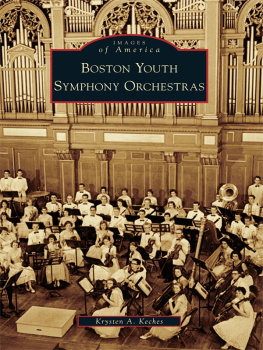Robert J. Flanagan - The Perilous Life of Symphony Orchestras: Artistic Triumphs and Economic Challenges
Here you can read online Robert J. Flanagan - The Perilous Life of Symphony Orchestras: Artistic Triumphs and Economic Challenges full text of the book (entire story) in english for free. Download pdf and epub, get meaning, cover and reviews about this ebook. year: 2012, publisher: Yale University Press, genre: Romance novel. Description of the work, (preface) as well as reviews are available. Best literature library LitArk.com created for fans of good reading and offers a wide selection of genres:
Romance novel
Science fiction
Adventure
Detective
Science
History
Home and family
Prose
Art
Politics
Computer
Non-fiction
Religion
Business
Children
Humor
Choose a favorite category and find really read worthwhile books. Enjoy immersion in the world of imagination, feel the emotions of the characters or learn something new for yourself, make an fascinating discovery.
- Book:The Perilous Life of Symphony Orchestras: Artistic Triumphs and Economic Challenges
- Author:
- Publisher:Yale University Press
- Genre:
- Year:2012
- Rating:4 / 5
- Favourites:Add to favourites
- Your mark:
- 80
- 1
- 2
- 3
- 4
- 5
The Perilous Life of Symphony Orchestras: Artistic Triumphs and Economic Challenges: summary, description and annotation
We offer to read an annotation, description, summary or preface (depends on what the author of the book "The Perilous Life of Symphony Orchestras: Artistic Triumphs and Economic Challenges" wrote himself). If you haven't found the necessary information about the book — write in the comments, we will try to find it.
Robert J. Flanagan: author's other books
Who wrote The Perilous Life of Symphony Orchestras: Artistic Triumphs and Economic Challenges? Find out the surname, the name of the author of the book and a list of all author's works by series.
The Perilous Life of Symphony Orchestras: Artistic Triumphs and Economic Challenges — read online for free the complete book (whole text) full work
Below is the text of the book, divided by pages. System saving the place of the last page read, allows you to conveniently read the book "The Perilous Life of Symphony Orchestras: Artistic Triumphs and Economic Challenges" online for free, without having to search again every time where you left off. Put a bookmark, and you can go to the page where you finished reading at any time.
Font size:
Interval:
Bookmark:
Published with assistance from the Louis Stern Memorial Fund.
Copyright 2012 by Robert J. Flanagan.
All rights reserved.
This book may not be reproduced, in whole or in part, including illustrations, in any form (beyond that copying permitted by Sections 107 and 108 of the U.S. Copyright Law and except by reviewers for the public press), without written permission from the publishers.
Yale University Press books may be purchased in quantity for educational, business, or promotional use. For information, please e-mail (U.K. office).
Set in Ehrhardt type by Newgen North America.
Printed in the United States of America.
Library of Congress Cataloging-in-Publication Data
Flanagan, Robert J.
The perilous life of symphony orchestras : artistic triumphs and economic challenges / Robert J. Flanagan.
p. cm.
Includes bibliographical references and index.
ISBN 978-0-300-17193-8 (hardcover : alk. paper)
1. Symphony orchestrasEconomic aspects. I. Title.
ML3795.F548 2012
784.2068'1dc23
A catalogue record for this book is available from the British Library.
This paper meets the requirements of ANSI/NISO Z39.481992
(Permanence of Paper).
10 9 8 7 6 5 4 3 2 1
During the preparation of this study, I benefited from the comments and criticisms of many thoughtful and well-informed symphony musicians, orchestra managers, and board members in the United States and in Europe. I wish there were space to identify them all. I received valuable suggestions on specific topics from academic colleagues including Paul Dimaggio, Mel Reder, Greg Sandow, Lee Soderstrom, and James Van Horne. My wife, Susan R. Mendelsohn, and anonymous reviewers for the Yale University Press also provided valuable comments that helped shape the final manuscript. I am particularly grateful for the assistance of Bri Godfrey at Stanford University and the staff at Yale University Press in preparing the manuscript for publication.
The study relies on data from several sources. The League of American Orchestras provided me with data on finances and operations of U.S. symphony orchestras and patiently responded to my questions about the definitions and interpretations of some variables. Opera America also generously provided similar information on its member organizations. These organizations provide data under the condition that researchers not publish information that would permit the identification of economic or operational data for individual performing arts organizations. I have willingly accepted this condition, as my main interest was in conducting statistical analyses of the data to determine industry-wide trends and regularities.
There is occasional mention of financial aspects of particular orchestras, but these comments do not use any information provided by the League or Opera America. They rest instead on information found in publicly available tax returns (available for individual symphony orchestras and other not-for-profit organizations at www.guidestar.org, for example) or discussions in the print media.
Finally, I would like to thank the Graduate School of Business at Stanford University, my intellectual home since 1975, and the Netherlands Institute for Advanced Study, where much of the study of the economic issues facing European symphony orchestras was conducted during 2009, for providing financial support and environments that facilitated the completion of this work. Needless to say, none of the individuals or organizations mentioned above is responsible for the conclusions of the book.
and Symphony Orchestras
On February 26, 2008, the New York Philharmonic Orchestra, the oldest symphony orchestra in the United States, played a remarkable concert in Pyongyang, the capital city of North Korea, as part of an effort to use cultural exchange to thaw diplomatic relations between the two countries. The program included the national anthems of each country, the prelude to act 3 of Richard Wagners Lohengrin, Antonn Dvoks New World Symphony, and George Gershwins An American in Paris. The encores included compositions by Georges Bizet and Leonard Bernstein, along with a popular Korean folk song. Whatever the ultimate diplomatic effects, the concert itself was an artistic and popular triumph. The Economist (2008) reported, The orchestra received a rapturous standing ovation. Even North Koreas most senior attendee, Vice-President Yang Hyong Sop, readily got to his feet.
About six weeks earlier, the board of directors of the Columbus, Ohio, symphony orchestra, which had presented a critically acclaimed performance in Carnegie Hall ten years earlier, announced that their orchestra was near bankruptcy. Faced with several years of deficits, the board proposed to save about $2.5 million in the following years budget by reducing the number of full-time orchestra musicians from 53 to 31 and reducing the concert season from 46 to 34 weeks. Part-time musicians would be hired when necessary to fill the orchestras ranks. The musicians union subsequently rejected that proposal, citing the impact on the income of the symphonys musicians. In late September, following the cancellation of summer concerts and the 20078 concert season, the symphonys musicians ratified a new agreement that involved $1.3 million in reduced wages as well as forgone health and pension benefits. A later agreement negotiated in 2011 provided musicians with base pay equal to 64 percent of their pay in 2008 (Sheban 2011).
Both events were typical in the sense that, over longer periods, there are a significant number of U.S. orchestras that run surpluses and an even larger number that run deficits. Even the New York Philharmonic, one of the wealthiest symphony orchestras in the United States, faces significant economic challenges, with ever-growing expenses and declines in some types of performance revenue (Lubow 2004). Averaged over the 1987 through 2000 concert seasons, the financial balance for 63 large U.S. symphonies was negative (deficit), but the experience of individual orchestras was widely dispersed. Forty-six orchestras ran deficits on average, while 17 orchestras ran surpluses on average. But irrespective of their average position, all orchestras experienced considerable annual variation in their financial balance. In each year some orchestras ran significant surpluses, while others ran significant deficits, but none of the 63 orchestras had surpluses (or deficits) throughout the entire period. The next chapter sets out the foundation of the ongoing economic insecurity faced by symphony orchestras.
In year 2000 dollars, the overall financial balance for the median orchestra changed from a deficit of almost $49,000 in 1987 to approximate balance in 2000 following a strong growth of private contributions during the robust economy of the late 1990s. Most orchestras achieved their strongest financial position during 199799, when highly favorable general economic conditions prevailed. Finances again deteriorated during the recession that greeted the 21st century and the Great Recession that began in late 2007. This pattern signals the importance of general economic conditions on the financial health of orchestras, a phenomenon that receives more attention in . But many other factors influence an orchestras financial health, for whether general economic conditions are good or bad, financial outcomes vary enormously among individual orchestras.
Font size:
Interval:
Bookmark:
Similar books «The Perilous Life of Symphony Orchestras: Artistic Triumphs and Economic Challenges»
Look at similar books to The Perilous Life of Symphony Orchestras: Artistic Triumphs and Economic Challenges. We have selected literature similar in name and meaning in the hope of providing readers with more options to find new, interesting, not yet read works.
Discussion, reviews of the book The Perilous Life of Symphony Orchestras: Artistic Triumphs and Economic Challenges and just readers' own opinions. Leave your comments, write what you think about the work, its meaning or the main characters. Specify what exactly you liked and what you didn't like, and why you think so.












